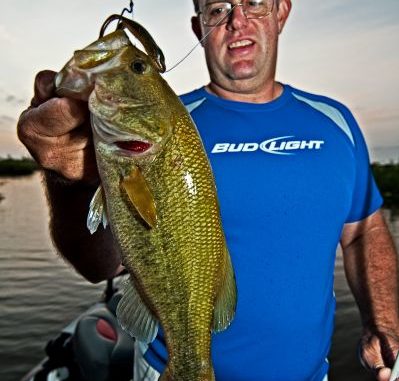
Topwater lures, soft-plastic worms get the job done.
Sunlight had barely dribbled over the horizon when Jeff Bruhl eased the throttle back on the Phoenix, crawled from behind the boat’s console and stepped up onto the front deck to drop the trolling motor.
As the eastern sky gradually lightened, the Covington angler ran a Stanley Ribbit along a marsh bank just off the West Pearl River.
The lure disappeared in a swirl a couple of casts later, and Bruhl pulled the first fish of the day from the water. And before the sun fully rose above the trees to the east, several other fish passed through the boat.
It was just another day on the snaking maze of bayous and river channelss along the Louisiana/Mississippi state line, Bruhl said.
“It’s a great place to bring a kid,” he said of the Pearl River complex. “There are just so many fish.”
The frog action slowed quickly, but Bruhl switched to a Berkley Frenzy popper and the topwater bite continued for about an hour.
Bruhl’s approach was to ease along the bank of the West Pearl tributary until a fish swiped at the lure. Whether he caught it or not — a few fish inexplicably slapped the treble hook-draped bait and failed to get hooked — the twin Power-Poles would go down to hold the fishing platform in place.
That paid big dividends as Bruhl sat in the mouth of Katrina Pond, a sprawling, shallow hole in the marsh ripped open by that mother of all hurricanes. Half a dozen bass were caught without the boat moving.
After thoroughly fishing the area, Bruhl moved to fishing drains on the main run of the West Pearl. The topwater bite had shut down by this time, but a Powerbait Chigger Craw yielded a fish or two at each run-out.
The morning trip wrapped up on the East Pearl River, where fish were scattered along the banks and fell for a combination of soft plastics and crankbaits.
In all, 20 to 30 fish were hauled in before 11 a.m. The heaviest would push the scales to about 2 pounds, but most of the bass were standard-issue marsh bass. But Bruhl said unless he’s fishing a tournament he enjoys the sheer number of bites.
But conditions are important to finding the fish in a feeding mood. And the West Pearl is the first to turn on.
“It’s like any river,” Bruhl said. “You get the spring floods, and it muddies up. And then in the summer, if you don’t get any rain, it clears up.
“A lot of times, I can come in here on the West Pearl and catch 10 to 12 pounds just because it’s clear.”
The key is the water level at the Pearl River gauge, Bruhl said.
“It has to be below 9 feet,” he explained. “At 9 feet, it muddies up — east, west and middle.”
And, of course, most of the fish are inaccessible when the river jumps up, anyway.
“It’s like the (Atchafalaya) Basin: When the water is high, they’ll be up in the woods eating crawfish,” Bruhl said.
So any river level of 9 feet or higher translates into tough fishing. But when the river drops out — which usually happens by the end of this month — fishing can be crazy.
“When it gets down in August, the West Pearl will be green green, and then it’s on like Donkey Kong,” Bruhl said.
Of course, the entire river system is influenced by the tide because the river feeds into the Rigolets. And that tidal flow dictates an angler’s approach.
“If the tide’s falling, you go fish run-outs and drains,” Bruhl said. ‘They’re (stacked up) to get the baitfish coming out of the drains.
“If the tide is up, you just go down the banks fishing.”
It’s important to note that a productive drain doesn’t have to be a huge cut in the bank.
“It can be 2 inches wide; as long as there’s bait coming out, they’ll be in there,” Bruhl said.
The West Pearl River has an advantage when the tide slackens, as it will happen over the next three days, because of one very important factor.
“There’s always current in the West Pearl,” Bruhl said.
That current plays a big part in success the farther upstream an angler goes.
“When you go north (from the mouth of the system), the fish will be in any current break,” Bruhl said. “You can go along fishing the downstream side of trees, and that’s where the fish will be. If you see a little cut in the bank, a fish could be right there.”